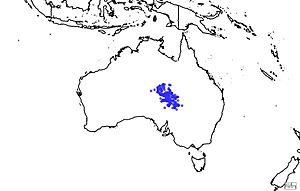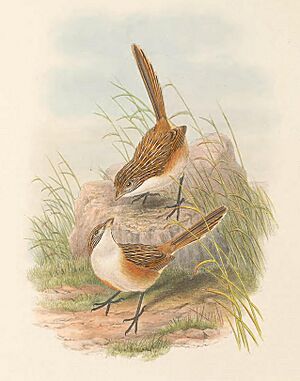Eyrean grasswren facts for kids
Quick facts for kids Eyrean grasswren |
|
|---|---|
 |
|
| Conservation status | |
| Scientific classification | |
 |
|
| Distribution of the Eyrean grasswren in Australia | |
| Synonyms | |
|
Goyder’s grasswren (obsolete) |
The Eyrean grasswren (Amytornis goyderi) is a small bird that lives in dry parts of Central Australia. It's a type of grasswren, which belongs to the Maluridae family. This bird is quite rare and hard to spot because its feathers help it blend in. It was first found in 1874 near Lake Eyre and named after George Woodroffe Goyder, a surveyor from South Australia.
Contents
What the Eyrean Grasswren Looks Like
The Eyrean grasswren is the smallest of all grasswrens, growing to about 14–16.5 centimeters long. It has a thick, finch-like beak. Male and female birds look very similar, but there are small differences.

Adult Males
Adult male Eyrean grasswrens have a reddish head with clear white stripes. Their neck and upper body are dull to bright reddish-brown, with thin dark and white lines. Their face is mostly white, except for a reddish forehead and a thin white ring under the eye. Black and white feathers cover their ears, separating the dark head from the off-white chin and throat.
Their tail is dark grey-brown with off-white shafts and light brown edges. The upper parts of their wings are also dark grey-brown, but they have bright white shafts and narrow reddish-brown edges. This creates reddish-brown patches when the wing is folded. The underside of their body is white, with a buff-brown color on their sides, legs, and under their tail.
Their beak is light grey to blue-grey, with a darker grey top part. Their eye is dark to olive-brown. Their legs and feet are purplish to dark grey.
Adult Females
Female Eyrean grasswrens look almost the same as males. However, the reddish-brown color on their sides is brighter. Their legs might be a slightly paler grey with more purple. Females are also a bit smaller overall and have a thinner beak.
Young Birds
Baby Eyrean grasswrens (nestlings) are born without feathers, but they have dark grey fuzz on their head and wings. Their skin is mostly pink, with dark blue-grey skin around their eyes. Young birds that have just left the nest have bright yellow edges around their beaks.
As they grow, they start to lose some of their baby feathers and grow new ones. Young birds look similar to adult males, but their upper parts are duller and browner. Their stripes and face patterns are less clear. They also have fluffier feathers, which can make their face look patchy. Their eyes are olive, and their beak is light grey, without the dark top part seen in adults.
Family Tree and History
The Eyrean grasswren was first described by John Gould in 1875. He thought it was related to the western grasswren because they looked similar. For many years, scientists debated which other grasswrens it was most closely related to.
Thanks to modern studies that look at DNA, we now know that the Eyrean grasswren is closely related to the Kalkadoon grasswren and the Dusky grasswren. These birds likely developed from a common ancestor in Central Australia over the last 100,000 years. This happened as ice ages changed the plants in the area.
Where the Eyrean Grasswren Lives
The Eyrean grasswren lives in specific areas, mainly in the sand dunes of the Simpson Desert and Strzelecki Desert in Central Australia. These deserts are part of a huge area that drains into Lake Eyre. Most of these birds are found in South Australia, but some also live in southwestern Queensland and the Northern Territory.
Their numbers can change a lot. They are most common when there is plenty of canegrass, which is a type of grass they rely on. During dry periods, they might move to smaller, safer areas.
Their Home Environment
Eyrean grasswrens live in areas with sandhill canegrass (Zygochloa paradoxa) growing in clumps on large sand dunes. They also live where speargrass (Aristida holathera), spinifex (Triodia species), and dune pea (Swainsona rigida) grow among the canegrass.
Their typical home has grass clumps that are 1-4 meters tall and 2-3 meters wide, with bare ground between them. These birds rarely leave the dune slopes, but they are sometimes seen in the low areas between dunes.
How They Behave
We don't know a lot about the Eyrean grasswren's behavior, but scientists believe they stay in one area. They are usually seen alone, in pairs, or in small groups of up to ten birds. They are very good at hiding within the canegrass clumps, making them hard to spot.
They rarely fly. When they do, they usually hop with their wings partly open between grass clumps or fly short distances (up to 10 meters) with their tail trailing behind. They have a special way of moving that is "half running, half flying" close to the ground. They quickly hop and fly for short bursts of 40–220 centimeters. Their movements are fast and secretive, and they usually hold their tail up. Sometimes, they will perch low (about 1 meter high) on branches of grevillea plants, canegrass, or other shrubs.
What They Eat
The Eyrean grasswren eats about equal amounts of plants and insects. Scientists have found seeds from grasses like Z. paradoxa and Aristida holathera in their stomachs. They also found parts of many different kinds of insects.
They move with small hops while looking for food between clumps of spinifex and within clumps of dune pea. Sometimes, they will hop backward and shuffle their feet to uncover food hidden in the sand.
Reproduction and Life Cycle
Not much is known about how Eyrean grasswrens mate. We don't have information on how long it takes for eggs to be laid or to hatch. Nests with baby birds and eggs have been found from July to September. Young birds that have left the nest but still depend on their parents have been seen from May to September.
They usually lay 2-3 eggs that are broadly oval in shape. Scientists believe they are monogamous, meaning one male and one female mate for the breeding season. They likely breed throughout their range.
The female builds the nest, which takes about one week. Nests are tucked into the stems of grass clumps, usually less than 1 meter off the ground, in clumps of Z. paradoxa and Australian boxthorn. The nest is shaped like a cup or dome. It's made from grasses like A. holathera, with Z. paradoxa strands woven into the base. The inside of the nest is lined with finer grass and sometimes soft plant material or spider silk. Nests are usually spread out, but they might be closer together in areas with very good habitat.
Sounds They Make
Eyrean grasswrens make contact calls throughout the day, often as a call and response between birds. Both male and female adults sing. Their songs might be used to protect their territory or to keep the group together. They sing from low perches or on the ground, and they might sing more often during the breeding season.
Their songs are "distinctive" and sound like "beautiful silvery tunes, pip trills, and long, bursting staccatos." These sounds can sometimes be mixed together in excited bursts. You can hear their songs up to 100 meters away, while their quieter contact calls can be heard from 30-40 meters away. Their alarm calls are high and sharp, and louder than their contact calls.
Conservation Status
The IUCN listed the Eyrean grasswren as threatened in 1988. However, the IUCN now lists it as least concern. This means they believe the species is not declining and its numbers likely go up and down with the seasons.
The main threats to the Eyrean grasswren are anything that harms the quality of their sandhill canegrass habitat. This includes erosion caused by grazing animals like rabbits, camels, and livestock.
How We Learned About Them
The first record of the Eyrean grasswren came from an expedition in 1874. Six specimens were collected near the Macumba River on Lake Eyre. Two of these were sent to John Gould, who described them in 1875. These two specimens are now at the British Museum of Natural History. The others were lost.
For a long time, no more specimens were found until 1976. Since then, the species has been seen many times. However, because these birds are so good at hiding and live in remote areas, we still don't know much about their behavior. Some attempts to catch them failed because they are so small they could pass through the nets!
See also
 In Spanish: Maluro del Eyre para niños
In Spanish: Maluro del Eyre para niños


